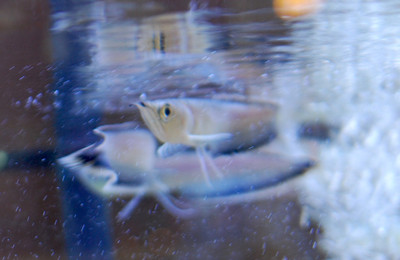Black Arowanas
Posted by Max Gandara on on 3rd Sep 2025
Black Arowana (Osteoglossum ferreirai) is a rare and fascinating freshwater fish that has become highly sought after by experienced aquarists. Closely related to the more well-known Silver Arowana, the Black Arowana is admired for its sleek body, powerful swimming ability, and striking appearance. Originating from the Rio Negro and other blackwater tributaries of the Amazon Basin, this fish is both majestic and captivating, making it a true centerpiece in any large aquarium.
Appearance
Juvenile Black Arowanas are especially eye-catching, with deep black bodies marked by bright orange or red highlights on their fins. As they mature, their coloration softens, shifting toward a dark metallic silver with subtle black undertones. Adults typically reach lengths of 3 feet or more in captivity, with an elongated, streamlined body, large scales, and a distinctive upturned mouth designed for surface feeding.
Behavior
Black Arowanas are predatory by nature. In the wild, they are known to leap from the water to catch insects, small birds, and amphibians. In captivity, they remain surface-oriented hunters, often gliding just below the water’s surface. They are generally solitary and can be territorial, so keeping them with other large fish requires careful planning. Despite their aggressive feeding habits, they can become accustomed to their owners and may even take food directly from hand.
Tank Requirements
Due to their large adult size, Black Arowanas require very spacious aquariums. A minimum of 250 gallons is recommended, with larger tanks being ideal. The aquarium should have a tightly secured lid, as Arowanas are excellent jumpers and can easily leap out. A long, wide tank is better than a tall one, as it gives them room to swim horizontally. Gentle water flow, strong filtration, and open swimming space are essential. Decorations should be minimal, though driftwood and subdued lighting help mimic their natural environment.
Water Parameters
Temperature: 75–82°F
pH: 6.0–7.0
Water Hardness: Soft to moderately hard
These fish thrive in warm, clean, and slightly acidic conditions, reflecting the blackwater habitats they come from. Excellent filtration and frequent water changes are necessary to maintain stable, high-quality water.
Diet
Black Arowanas are strict carnivores. In the wild, they feed on insects, crustaceans, smaller fish, and even terrestrial animals they catch by leaping from the water. In captivity, they can be fed live or frozen foods such as shrimp, fish, crickets, and mealworms. Over time, some may accept high-quality carnivore pellets, which help balance their diet. A varied feeding routine is important to keep them healthy and strong.
Tank Mates
Because of their predatory instincts, Black Arowanas should only be housed with other large, robust species. Good companions include large catfish, stingrays, big cichlids, and similar-sized predatory fish. Small or slow-moving fish are at risk of being eaten. Even with large tank mates, aggression can sometimes occur, so compatibility should be monitored closely.
Challenges in Keeping Black Arowanas
Their size, specialized care needs, and diet make Black Arowanas a challenging species suited for advanced aquarists. They require massive aquariums, strong filtration, and a dedicated feeding routine. Their jumping behavior is another challenge, as inadequate lids can result in injury or escape. Additionally, their rarity in the aquarium trade makes them harder to obtain and often more expensive than Silver Arowanas.
Conclusion
The Black Arowana is a stunning and rare freshwater predator that commands attention in any aquarium. With its sleek body, powerful presence, and fascinating behavior, it is both a challenge and a reward to keep. While best suited for experienced fish keepers with the space and resources to provide proper care, those who succeed are rewarded with one of the most striking and majestic fish in the hobby.
Do you want me to make this into the same **plain text, easy-to-copy version** like I did with the Indo Datnoid?

